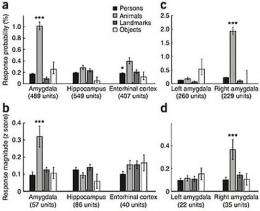August 30, 2011 report
Research team finds human brain particularly sensitive to images of animals

(Medical Xpress) -- Scientists have long known that the right amygdala (one of two almond-shaped parts of the brain located deep with the temporal lobes) is heavily involved in processing memory and emotional responses to external stimuli; now however it appears that this tiny part of our brain also responds quite excitedly, to images of animals. Florian Mormann and colleagues from Caltech have discovered that large numbers of neurons in the right amygdala light up when a person looks at images of animals. The group have published the results of their study in Nature Neuroscience.
To find out how the right amygdala responds to external stimuli, in this case, images in photographs, the researchers worked with a group of 41 people experiencing epilepsy symptoms that had not responded to pharmaceutical therapies, and whose next option was surgery. But before the surgery could be performed, each patient had to undergo implantation of electrodes into their brains so surgeons could map the different areas of neural activity to ascertain which parts needed corrective procedures. The implanted electrodes provided a window of opportunity for the researchers, as they allowed the team to measure neural activity in the right amygdala (pronounced -- a MIG duh luh) as they were being shown photographs of people, inanimate objects, and of course animals.
The team found that in virtually all cases, the neurons in the right amygdala lit up when shown pictures of animals, but not of people or other objects. Also, it didn’t matter what kind of animal was shown; big or small, soft and cuddly or mean and ferocious, the response was the same.
The research team speculates that early in human history, a part of the brain developed to specifically respond, very rapidly, to animals because back then, animals generally either meant threat or food. Both required rapid, appropriate responses, so a part of the brain evolved to deal with either. Not unlike how special processors are embedded in modern computer “brains” to deal very quickly with particular I/O functions so that the rest of the brain can continue to process everything else.
As part of the study, the team also used magnetic resonance imaging to watch the amygdala of volunteer subjects who were shown the same kinds of photographs as the first group and found the same sort of responses in non-epileptic patients.
The team next plans to look into whether other types of stimuli, such as animal noises, or odors, cause similar reactions in the brain as well.
More information: A category-specific response to animals in the right human amygdala, Nature Neuroscience (2011) doi:10.1038/nn.2899
Abstract
The amygdala is important in emotion, but it remains unknown whether it is specialized for certain stimulus categories. We analyzed responses recorded from 489 single neurons in the amygdalae of 41 neurosurgical patients and found a categorical selectivity for pictures of animals in the right amygdala. This selectivity appeared to be independent of emotional valence or arousal and may reflect the importance that animals held throughout our evolutionary past.
© 2011 PhysOrg.com














